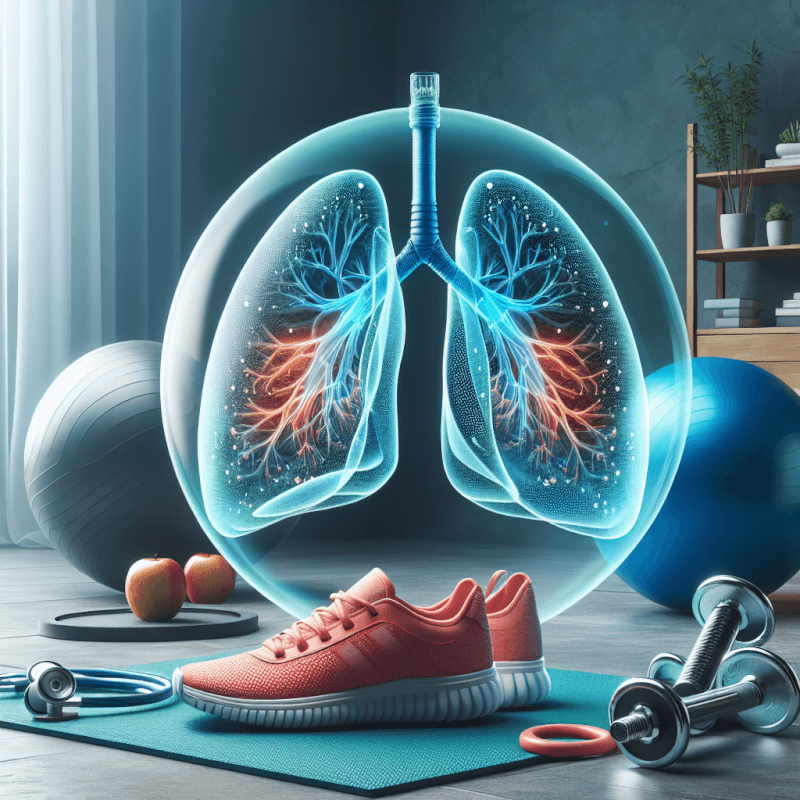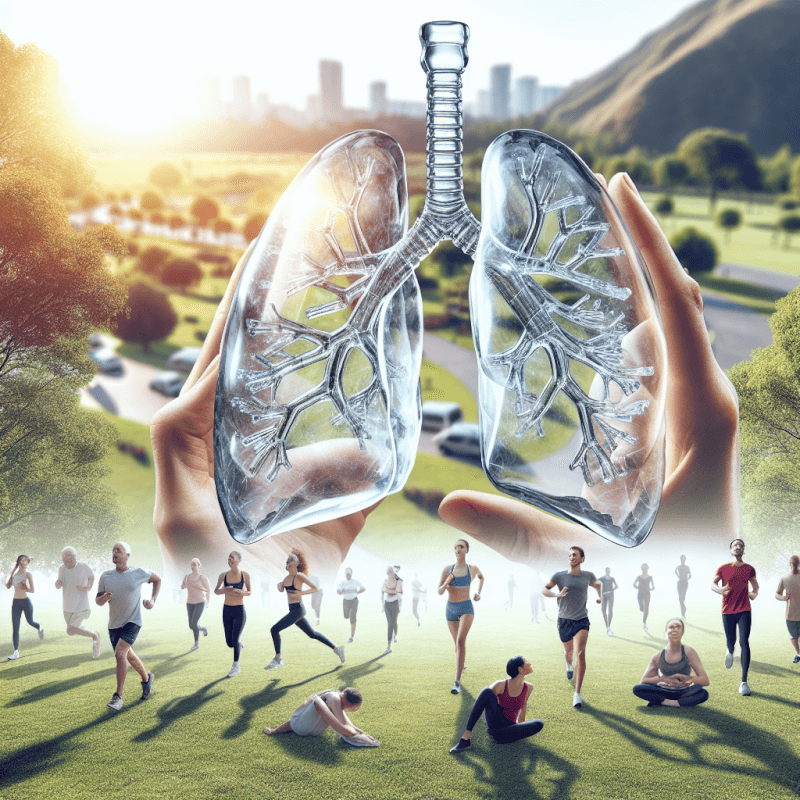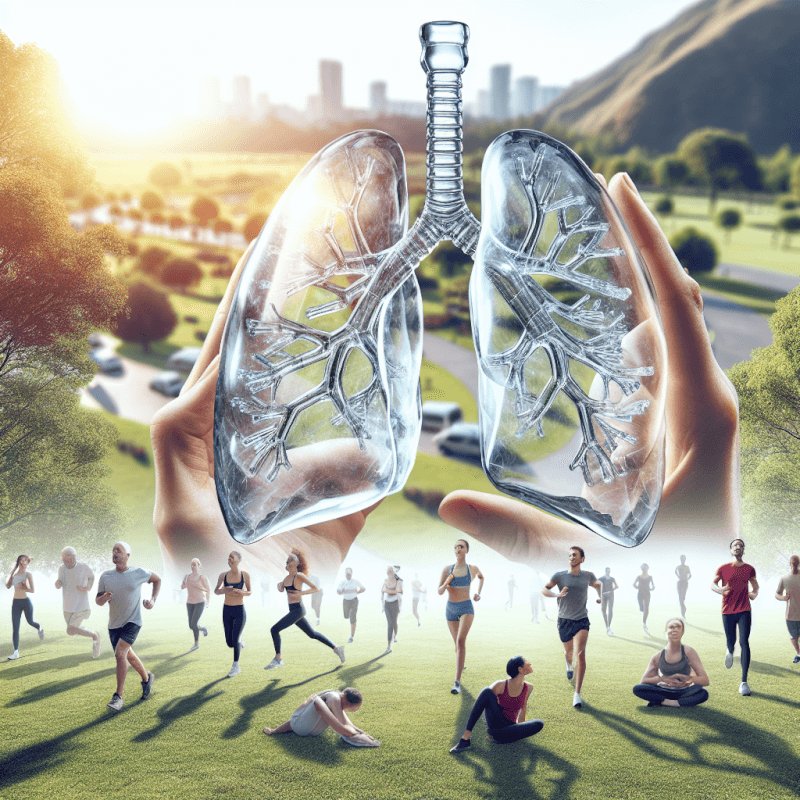If you’ve ever wondered how to enhance your lung capacity and overall respiratory health, look no further than exercise. Engaging in regular physical activity not only strengthens your muscles and improves cardiovascular endurance, but it can also have a positive impact on your lungs. Through various forms of exercise such as aerobic workouts, running, swimming, or even brisk walking, you can effectively increase your lung capacity and improve the efficiency of your respiratory system. Discover the incredible benefits exercise can bring to your lungs and take a step towards better health today.

Importance of Lung Capacity and Respiratory Health
Lung capacity and respiratory health play a crucial role in maintaining a healthy lifestyle. Your lungs are responsible for bringing in oxygen and expelling carbon dioxide, ensuring that every cell in your body receives the oxygen it needs to function properly. When your lung capacity is diminished or your respiratory health is compromised, it can lead to a variety of health issues. Therefore, understanding the importance of lung capacity and respiratory health is essential for your overall well-being.
Understanding Lung Capacity
Lung capacity refers to the maximum amount of air your lungs can hold. It is influenced by factors such as age, gender, height, and physical condition. Higher lung capacity allows you to take in larger amounts of oxygen, which is beneficial for various daily activities, especially during exercise or vigorous physical exertion. By improving lung capacity, you can enhance your endurance, stamina, and overall fitness levels.

The Significance of Respiratory Health
Having good respiratory health ensures optimal functioning of your respiratory system, which includes your lungs, airways, and diaphragm. A healthy respiratory system allows for efficient oxygen intake and carbon dioxide elimination, aiding in the proper functioning of other organs and bodily systems. Additionally, maintaining respiratory health reduces the risk of respiratory diseases, such as chronic obstructive pulmonary disease (COPD) and asthma, and improves overall quality of life.
Factors Affecting Lung Capacity and Respiratory Health
Several factors can affect lung capacity and respiratory health. Understanding these factors can help you make informed choices to maintain and improve them.
Age
As you age, your lung capacity naturally decreases. This is influenced by changes in lung elasticity and overall physical fitness. It becomes important to engage in regular exercise and breathing techniques to preserve and enhance lung capacity as you grow older.
Smoking
Smoking is a major contributor to respiratory health issues. The chemicals in tobacco smoke damage the delicate tissues of the lungs and irritate the airways, leading to chronic respiratory conditions such as COPD, lung cancer, and emphysema. Quitting smoking and avoiding exposure to secondhand smoke are essential steps towards improving lung capacity and respiratory health.
Environmental Factors
Exposure to air pollution, allergens, and industrial chemicals can have a detrimental impact on lung capacity and respiratory health. Prolonged exposure to harmful substances can lead to respiratory diseases and exacerbate existing conditions. It is crucial to minimize exposure to polluted environments and ensure good indoor air quality to maintain healthy lungs.
Diseases and Conditions
Certain diseases and conditions can affect lung capacity and respiratory health. Conditions such as asthma, bronchitis, and pneumonia can weaken the lungs and reduce their efficiency. Seeking appropriate medical treatment and following recommended lifestyle changes are necessary for managing these conditions and maintaining respiratory health.

Exercise and Its Impact on Lung Capacity
Regular exercise has numerous benefits for lung capacity and respiratory health. Engaging in physical activity strengthens the respiratory muscles, increases lung efficiency, and enhances oxygen uptake. By incorporating exercise into your routine, you can improve your lung capacity and overall respiratory health.
Types of Exercise
There are two main types of exercise: aerobic exercise and strength training. Both have unique impacts on lung capacity and respiratory health.
Aerobic Exercise and Lung Capacity
Aerobic exercise, also known as cardio exercise, increases your heart rate and promotes efficient oxygen usage. Activities such as brisk walking, running, swimming, and cycling require sustained and rhythmic movements, stimulating the respiratory system. Regular aerobic exercise can improve lung capacity by enhancing the ability of the lungs to take in oxygen and expel carbon dioxide.
Strength Training and Lung Capacity
Strength training exercises, also known as resistance training or weightlifting, primarily focus on building muscle strength and endurance. While these exercises may not have a direct impact on lung capacity, they support overall respiratory health by strengthening the muscles involved in breathing. This enables the respiratory muscles to work more efficiently, allowing for increased lung capacity during physical exertion.
Specific Exercises to Improve Lung Capacity
To specifically target lung capacity improvement, there are several exercises you can incorporate into your routine. These cardiovascular activities help to strengthen the respiratory muscles and enhance lung efficiency.
Running and Jogging
Running and jogging are excellent exercises to improve lung capacity. By engaging in these high-intensity activities, you challenge your lungs to deliver more oxygen to your working muscles. Over time, consistent running or jogging can lead to an increase in lung capacity as your respiratory system adapts to the demands of the exercise.
Swimming
Swimming is a low-impact, full-body workout that engages the respiratory muscles and enhances lung capacity. The resistance of the water provides a challenging environment, forcing your lungs to work harder to take in oxygen and expel carbon dioxide. Incorporating swimming into your exercise routine can contribute to improved lung capacity and overall respiratory health.
Cycling
Cycling is another cardiovascular exercise that can help improve lung capacity. It provides a moderate to high-intensity workout, which requires efficient breathing to maintain optimal oxygen intake. Regular cycling strengthens the respiratory muscles and can lead to increased lung capacity over time.
Brisk Walking
Brisk walking is a low-impact exercise that can be easily incorporated into daily routines. It promotes deep breathing, effectively increasing lung capacity. By gradually increasing your walking speed and distance, you can challenge your respiratory system and improve its efficiency.
Interval Training
Interval training involves alternating between periods of high-intensity exercise and rest or lower-intensity activity. This type of exercise can significantly improve lung capacity by challenging the respiratory system to take in more oxygen during intense bursts of activity. Incorporating interval training into your exercise routine can help boost overall respiratory health.

Breathing Techniques for Respiratory Health
In addition to exercise, specific breathing techniques can help improve respiratory health and enhance lung capacity. These techniques focus on optimizing breathing patterns and efficiency.
Diaphragmatic Breathing
Also known as belly breathing, diaphragmatic breathing involves using the diaphragm muscle to take slow, deep breaths. This technique helps to maximize the expansion of the lungs, allowing for increased oxygen intake and improved lung capacity. Practice diaphragmatic breathing regularly to enhance overall respiratory health.
Pursed Lip Breathing
Pursed lip breathing involves inhaling deeply through the nose and exhaling slowly through pursed lips. This technique promotes optimal oxygen exchange, preventing the collapse of small airways and enhancing lung capacity. Pursed lip breathing is particularly helpful during periods of physical exertion or when experiencing shortness of breath.
Lip Breathing
Lip breathing involves breathing in and out through slightly pursed lips, similar to pursed lip breathing. This technique helps to regulate and control the rate of breathing, enabling efficient oxygen uptake and promoting lung capacity improvement. Lip breathing can be practiced during both restful activities and exercise.
Alternate Nostril Breathing
Alternate nostril breathing is a yogic breathing technique that involves alternating breathing through each nostril. This practice helps to balance the flow of energy and oxygen between the two sides of the body, promoting healthy respiratory function. Regular practice of alternate nostril breathing can enhance lung capacity and overall respiratory health.
Buteyko Breathing Method
The Buteyko Breathing Method focuses on reducing the amount of breathing, aiming to normalize breathing patterns and increase lung efficiency. This technique involves breathing less air, promoting optimal carbon dioxide levels in the body. By practicing the Buteyko Breathing Method, you can improve lung capacity and respiratory health over time.
Benefits of Regular Physical Activity on Respiratory Health
Incorporating regular physical activity into your routine has countless benefits for respiratory health. Here are some of the ways exercise can positively impact your lungs and overall respiratory well-being.
Improved Lung Function
Regular exercise strengthens the respiratory muscles and increases lung efficiency, resulting in improved lung function. This leads to a greater ability to take in oxygen and expel carbon dioxide, enhancing overall respiratory health.
Enhanced Oxygen Intake
Engaging in physical activity boosts oxygen uptake, allowing your body to efficiently deliver oxygen to all organs and tissues. Improved oxygen intake supports cellular function and promotes overall well-being.
Reduced Risk of Respiratory Diseases
Regular exercise can reduce the risk of respiratory diseases such as COPD, asthma, and lung cancer. By maintaining good respiratory health through exercise, you can lower the chances of developing these conditions.
Strengthened Respiratory Muscles
Physical activity helps strengthen the respiratory muscles, including the ones directly involved in breathing. This results in better muscle endurance and enhanced lung capacity.
Enhanced Stamina and Endurance
Regular exercise increases your overall fitness levels, leading to improved stamina and endurance. This means that your respiratory system can efficiently support sustained physical activity without becoming overwhelmed or fatigued.

Incorporating Exercise into Daily Routine
To make exercise a sustainable part of your daily routine, follow these guidelines:
Setting Realistic Goals
Set achievable goals that are specific, measurable, attainable, relevant, and time-bound (SMART). Gradually increase the intensity and duration of your exercise routine to avoid injury and ensure long-term adherence.
Choosing Activities That Suit Your Lifestyle
Select activities that you enjoy and that are practical for your lifestyle. Consider factors such as time availability, accessibility, and personal preferences. When exercise is enjoyable, it becomes easier to maintain consistency.
Creating a Structured Exercise Plan
Develop a structured exercise plan that includes a variety of activities and accounts for different aspects such as aerobic exercise, strength training, and flexibility. Having a plan in place will help you stay organized and motivated.
Making Exercise a Habit
Make exercise a regular habit by scheduling it into your daily or weekly routine. Treat it as a non-negotiable part of your day, just like any other essential activity. Consistency is key to reaping the benefits of regular exercise.
Seeking Professional Guidance
If you are new to exercise or have specific health concerns, consider seeking guidance from a healthcare professional or certified fitness trainer. They can help you design an exercise program that is tailored to your individual needs and goals.
Precautions and Safety Measures
To ensure a safe and effective exercise experience, it’s important to take certain precautions and follow safety measures:
Consulting a Healthcare Professional
If you have any pre-existing health conditions or concerns, consult with a healthcare professional before starting an exercise program. They can provide personalized advice and ensure that you exercise safely.
Gradually Increasing Intensity
Avoid pushing yourself too hard too soon. Gradually increase the intensity and duration of your exercise as your fitness level improves. This will allow your body to adjust gradually and reduce the risk of injuries or overexertion.
Proper Warm-up and Cool-down
Always start your exercise routine with a warm-up to prepare your body for physical activity. This can include light aerobic movements and stretching. Similarly, finish your workouts with a cool-down and gentle stretching to gradually lower your heart rate and prevent muscle soreness.
Avoiding Exposure to Air Pollution
Exercise outdoors in areas with good air quality, and be mindful of high pollution levels. Exercising indoors on days with poor air quality or using air purifiers can help minimize exposure to pollutants, which can negatively affect respiratory health.
Listening to Your Body
Pay attention to your body’s signals during exercise. If you experience chest pain, dizziness, shortness of breath, or any other concerning symptoms, stop exercising and seek medical attention. It’s important to be in tune with your body’s limits and adjust your exercise routine accordingly.
Healthy Lifestyle Habits to Support Respiratory Health
In addition to regular exercise, adopting healthy lifestyle habits can further enhance respiratory health. Consider incorporating the following practices into your daily routine:
Maintaining a Balanced Diet
Eating a balanced diet rich in fruits, vegetables, whole grains, lean proteins, and healthy fats provides essential nutrients that support respiratory health. Certain vitamins and minerals, such as vitamin C and omega-3 fatty acids, have been associated with improved lung function.
Staying Hydrated
Drinking an adequate amount of water helps maintain optimal mucus production and thinning, which aids in the clearance of respiratory secretions. Staying hydrated also supports overall bodily functions and enhances overall well-being.
Avoiding Smoking and Secondhand Smoke
Quitting smoking and avoiding exposure to secondhand smoke are critical for respiratory health. Smoking not only damages the lungs but also weakens the overall respiratory system, making it more susceptible to infections and respiratory diseases.
Preventing Respiratory Infections
Practicing good hygiene, such as washing hands frequently and properly, can help prevent the spread of respiratory infections. Getting vaccinated against diseases such as influenza and pneumonia can also reduce the risk of respiratory infections.
Practicing Good Posture
Maintaining good posture supports optimal lung function by allowing the lungs to expand fully and facilitating efficient breathing. Avoid slouching and practice exercises that strengthen the muscles responsible for good posture, such as core exercises and back stretches.
Maintaining a Healthy Weight
Excess weight can compress the lungs and impede proper functioning. Maintaining a healthy weight through a combination of regular exercise and a balanced diet promotes respiratory health and reduces the risk of respiratory conditions.
Conclusion
Improving lung capacity and maintaining respiratory health through exercise and lifestyle habits is crucial for your overall well-being. By understanding the significance of lung capacity and respiratory health, identifying factors that can affect them, incorporating specific exercises and breathing techniques, and adopting healthy lifestyle habits, you can enhance your lung capacity and overall respiratory health. Remember to exercise regularly, consult with healthcare professionals when necessary, listen to your body, and make conscious choices that support your respiratory well-being. By prioritizing your lung capacity and respiratory health, you are taking active steps towards a healthier and more fulfilling life.


